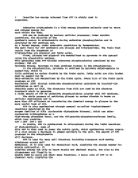Phospholipids are fats which contain nitrogen and phosphorus in addition to carbon, hydrogen and oxygen. Their roles in organisms are structural as an important component of plasma membranes, as a transport of fat and some as a source of choline and others concerned with blood clotting. An important phospholipid in the body is lecithin, which has the following formula:
Fig.2 Lecithin4
Choline, a constituent of lecithin is a strong, nitrogen containing base which is important in preventing excess fat forming in the liver. Ion the absence of choline a condition called fatty liver, which is the first stage of liver degeneration occurs. When choline is acetylated it forms acetyl-choline, a substance which is very important in transmission of nerve impulses.
Phospholipids combine hydrophilic properties of the phosphate group with their hydrophobic properties in the fatty part of the molecule. They are therefore said to be bipolar substances and at an interface where water is present the phospholipid molecule align themselves with the phosphate radicles buried in the water and the fatty tails sticking out of the water. Phospholipids are constituents of all animals and plant cells but are present in abundance in nervous tissue, heart, kidney and egg yolk. Phospholipids are soluble in water to some extent and are found in high concentration in the blood when fat stores are being mobilised and when fatty acids are being absorbed in the gut. Fatty acids are absorbed by forming compounds with bile salts, then the bile salts are freed as the fatty acids are converted to phospholipids in the cells of the gut wall.1
The cell surface membrane is the boundary between the cell and its environment and is a double layer of phospholipid molecules. These allow lipid soluble substances into the cell whilst keeping water soluble molecules. These also maintain the fluidity of the membrane. The phosphate head is hydrophilic and the fatty acid tail is hydrophobic.2
Steroids play an important part in the emulsification of fats in the small intestine. Caliciferol and other pro-vitamin D steroids are produced by irradiation of ergosterol with ultraviolet light. Oestrogens and androgens are also steroids. Sterols include hormones of the adrenal cortex and certain cancer-inducers.5
Aquatic organisms use an evolutionary strategy for hydrostatic buoyancy control: they reduce overall body density and air volume by increasing the amounts of lipids and blubber. With a low-density body, there is no longer a need for a large air volume in the lungs to compensate for negative buoyancy. This decreases the range of buoyant forces and allows them to change depth frequently and rapidly without continual adjustment of their buoyancy to compensate.6
Because of their hydrophobic nature, lipids, in particular as waxes are good waterproofing agents, often in leaves and in birds.7 Lipids provide electrical insulation as they protect the nerves and help conduct electro-chemical impulses in the form of a myelin sheath.8 Humans in particular rely on fatty adipose tissue for insulation as this has a lower thermal conductivity than other body tissues and so conducts heat more slowly to the surroundings.2 Desert animals such as the kangaroo rat and the camel yield water when triglycerides are oxidised and store fat for its metabolic water content.9
1Biology of the Mammal Second Edition – Clegg & Clegg, 1968
2Biology Second Edition – Boyle & Senior, 2002
3Louisiana State University Department of Biology –
4University of Tennessee, Knoxville –
5 Plant and Animal Biology Volume 2 – Vines & Rees, 1967
6Earth Systems Science & Policy Institute, California State University, Monterey Bay - http://essp.csumb.edu/
7University of Tennessee at Martin –
8Wright State University School of Medicine - http://www.med.wright.edu
9Curriculum Press –







